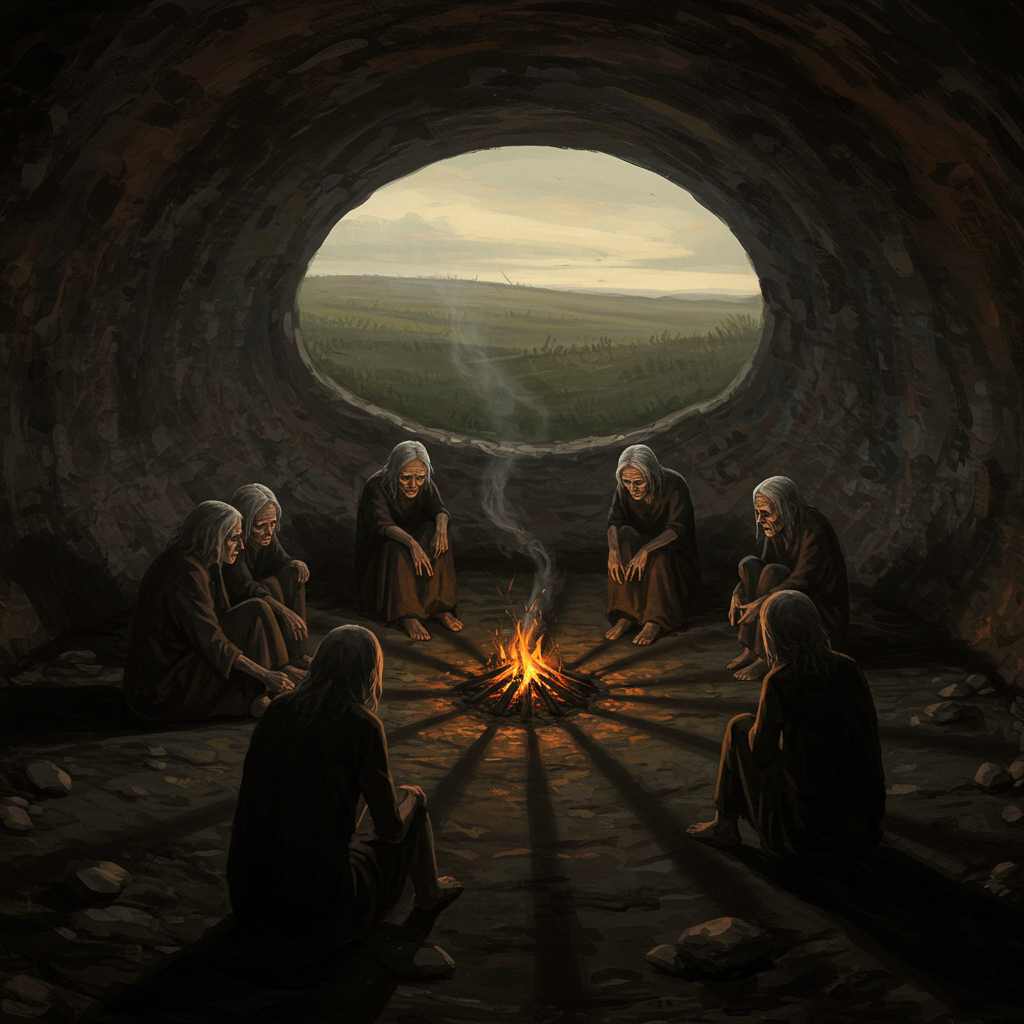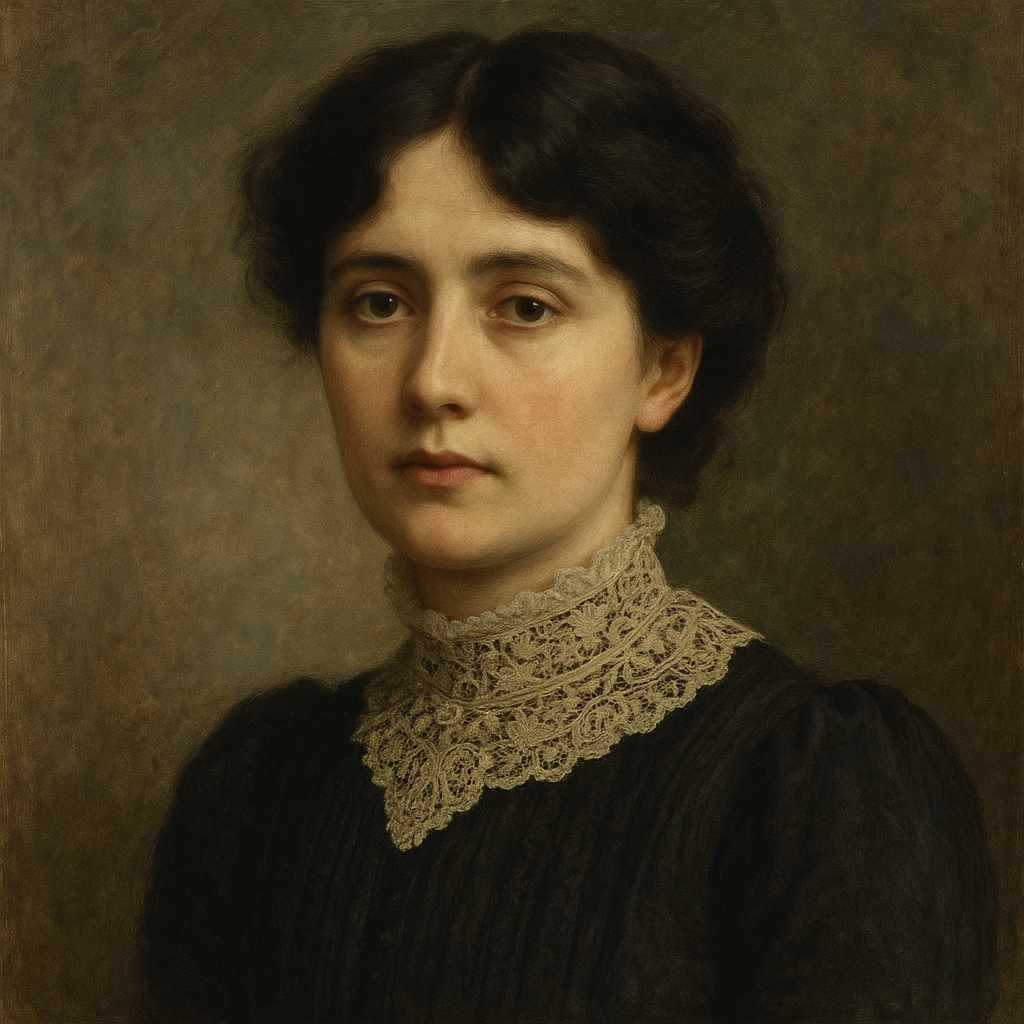The Forgetful People
Nora Hopper Chesson
1871 to 1906

Be still, be still, Folk of the Hill,
And cry not through our dreams,
For years have had of us their will,
And only firelight streams
Upon our hands that are empty,
And we forget our dreams.
Shade, sun, and wind to you are kind,
But we have chosen the fire
To flicker and fade in eyes half blind,
And no more dear desire
There is in our souls grown shrivelled
That sleep beside the fire.
We fain would keep an endless sleep,
For naught is left to dream;
We would not hear you when you weep
Though sweet your voices seem.
We are more sad than dreams are
Forgetting how to dream.
Nora Hopper Chesson's The Forgetful People
Nora Hopper Chesson’s The Forgetful People is a haunting meditation on memory, loss, and the erosion of desire. Composed in the late 19th or early 20th century, the poem reflects the broader fin-de-siècle preoccupation with decay, weariness, and the fading of vitality—a theme prevalent in the works of poets like W.B. Yeats and Arthur Symons. Chesson, an Anglo-Irish writer associated with the Celtic Revival, often wove folklore and melancholy into her verse, and The Forgetful People is no exception. The poem’s speakers—presumably spirits or aged beings—lament their detachment from life, their inability to dream, and their resignation to the dim glow of the firelight, a symbol of waning existence. Through its evocative imagery, rhythmic cadence, and poignant resignation, the poem explores the tragedy of forgetting, not just as a loss of memory but as a loss of self.
Historical and Cultural Context
To fully appreciate The Forgetful People, one must situate it within the Celtic Revival, a movement that sought to reclaim and romanticize Ireland’s mythic past. Chesson, though less celebrated than contemporaries like Yeats or Lady Gregory, contributed to this literary resurgence with her lyrical, folk-inspired poetry. The poem’s tone aligns with the Revival’s fascination with the supernatural, the elegiac, and the liminal spaces between life and death. The “Folk of the Hill” may allude to the Aos Sí, the fairy folk of Irish mythology, often depicted as ancient, sorrowful beings who exist outside of human time.
Moreover, the late Victorian and early modernist periods were marked by a sense of existential fatigue—a response to industrialization, the erosion of tradition, and the spiritual crises of the age. The poem’s weary resignation mirrors the broader cultural anxiety about progress and the loss of enchantment. The firelight, which recurs as a central image, could symbolize both comfort and decline—warmth in the face of encroaching darkness, but also the last flicker before extinction.
Themes: The Death of Desire and the Burden of Memory
At its core, The Forgetful People is a poem about the extinction of longing. The speakers address the “Folk of the Hill” (perhaps younger, still-dreaming spirits) with a plea for silence, as they themselves have lost the capacity to dream. The lines, “For years have had of us their will, / And only firelight streams / Upon our hands that are empty, / And we forget our dreams” suggest a surrender to time’s passage. Unlike the addressees, who still interact with the natural world (“Shade, sun, and wind to you are kind”), the speakers have withdrawn into a static, firelit existence.
The poem’s most devastating admission is not merely that they have forgotten their dreams, but that they no longer care to remember them. The line “We are more sad than dreams are / Forgetting how to dream” implies a double loss: first, the disappearance of dreams themselves, and second, the atrophy of the very faculty that produces them. This is a profound psychological and spiritual stagnation—a living death.
Literary Devices: Sound, Imagery, and Structure
Chesson’s poem achieves its melancholic power through carefully crafted sound and imagery. The repetition of “be still, be still” creates a hypnotic, almost incantatory rhythm, reinforcing the speakers’ desire for quietude and their separation from the vibrant world outside. The assonance in “streams,” “dreams,” “seem,” and “sleep” produces a mournful musicality, while the alliteration in “flicker and fade” and “souls grown shrivelled” emphasizes the gradual diminishment of vitality.
The dominant imagery is that of light and shadow. The firelight, though traditionally a symbol of home and warmth, here becomes a prison—a dim, unchanging glow that neither nourishes nor illuminates fully. The contrast between the natural elements (“Shade, sun, and wind”) and the artificial, dwindling fire underscores the speakers’ self-imposed exile from life. Their hands are “empty,” their souls “shrivelled,” and their existence reduced to a half-conscious state beside the hearth.
Structurally, the poem’s two stanzas mirror each other in tone and theme, reinforcing the cyclical, unchanging nature of the speakers’ condition. The first stanza introduces their plea for silence and their admission of forgetfulness; the second deepens the despair by revealing their voluntary surrender to oblivion. There is no resolution, only a quiet, unbroken sigh of resignation.
Philosophical and Psychological Underpinnings
The poem resonates with existential and psychological themes. Philosophically, it aligns with Schopenhauer’s notion of life as a pendulum between pain and boredom—the speakers have moved beyond desire into a state of numb acceptance. Psychologically, the poem anticipates modernist concerns about alienation and the loss of meaning. The “forgetful people” are not just individuals who have lost memories; they are beings who have lost their narrative—their sense of purpose and continuity.
Comparatively, one might read The Forgetful People alongside T.S. Eliot’s The Hollow Men (1925), which similarly explores spiritual emptiness and the inability to engage with life. Both poems depict figures trapped in a liminal space, though Chesson’s tone is more sorrowful than Eliot’s fragmented despair. Another apt comparison is Yeats’ The Stolen Child, where fairies lure a child away from a world of sorrow—except in Chesson’s poem, the fairies (or their equivalents) are themselves sorrowful, having lost their own magic.
Emotional Impact and Universal Relevance
What makes The Forgetful People so affecting is its universality. While rooted in Celtic folklore, its central lament—the loss of dreams, the weariness of existence—transcends time and culture. Anyone who has felt the slow erosion of passion, the dulling of once-vivid hopes, will recognize the poem’s quiet tragedy. The speakers do not rage against their fate; they accept it with a sigh, making their resignation all the more heartbreaking.
The poem also raises poignant questions about memory and identity: Are we the sum of our dreams? If we forget them, do we cease to be ourselves? The firelight, then, becomes a metaphor for the last vestiges of consciousness—flickering, fragile, and ultimately insufficient to sustain true life.
Conclusion: A Whisper from the Shadows
Nora Hopper Chesson’s The Forgetful People is a masterful elegy for lost vitality. Through its mournful cadence, rich imagery, and profound thematic depth, the poem captures the quiet despair of those who have outlived their own desires. It is a work that lingers in the mind like the fading glow of embers—soft, sorrowful, and strangely beautiful. In an age increasingly defined by distraction and disenchantment, Chesson’s verse serves as a poignant reminder of what it means to truly live—and what it means to forget how.
This text was generated by AI and is for reference only. Learn more
Want to join the discussion? Reopen or create a unique username to comment. No personal details required!



Comments
No comments yet. Be the first to comment!